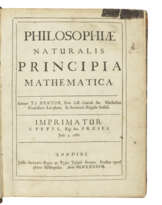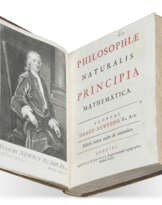ID 1249887
Lot 151 | [NEWTON, Isaac (1642-1727)]
Estimate value
£ 70 000 – 100 000
Analysis per quantitatum series, fluxiones, ac differentias: cum enumeratione linearum tertii ordinis [and other works, edited with a preface by William Jones]. London: Pearson, 1711.
Presentation copy of the first edition of Newton's first independent treatise on the higher mathematics, containing his discovery of the differential calculus, inscribed by the editor William Jones to his cousin William Griffith: ‘To my esteemed cousin Mr William Griffith This Book is humbly presented by Wm. Jones.’
This work includes the first printed appearances of Newton's ‘De analysi per aequationes numero terminorum infinitas’ and ‘Methodus differentialis’, as well as reprints of the tracts on quadratures and cubics first published in Opticks. De analysi, originally written in 1669 to protect his priority in the invention of the calculus, contains the earliest printed account of the binomial theorem. ‘In 1711, Newton permitted mathematician William Jones (one of the few allowed access to Newton's manuscripts) to publish these four tracts; aside from his association with Newton, Jones is chiefly remembered for having introduced the symbol π into mathematical notation’ (Norman). Jones’s edition of this and other texts earned him the fellowship of the Royal Society and he served on the Council several times, becoming Vice-President. Norman 1590; Babson 207.
Quarto (239 x 179mm). Engraved table on p. 62 and 2 double-page engraved tables by John Senex, 24 other engravings in the text showing 77 numbered figures, another unnumbered at p. 97, title with engraved vignette by Joseph Nutting, engraved head- and tailpieces, and 2 initials, a few woodcut ornaments (without final blank, occasional minor spotting and dust-stains, many leaves with faint crease at top corner made by a reader). Contemporary blindtooled panelled calf, spine in six compartments with raised bands gilt, red morocco lettering piece in the second panel, the others decorated in gilt, sprinkled red edges (joints split, spine chipped, corners and edges rubbed, some stains and slight scuffing). Provenance: Presentation copy from the editor William Jones to his cousin William Griffith (inscription on preliminary free blank).
| Artist: | Isaac Newton (1643 - 1727) |
|---|---|
| Place of origin: | England, Northern Europe, Europe, United Kingdom |
| Auction house category: | Books and manuscripts, Printed books |
| Artist: | Isaac Newton (1643 - 1727) |
|---|---|
| Place of origin: | England, Northern Europe, Europe, United Kingdom |
| Auction house category: | Books and manuscripts, Printed books |
| Address of auction |
CHRISTIE'S 8 King Street, St. James's SW1Y 6QT London United Kingdom | |
|---|---|---|
| Preview |
| |
| Phone | +44 (0)20 7839 9060 | |
| Buyer Premium | see on Website | |
| Conditions of purchase | Conditions of purchase |
![[NEWTON, Isaac (1642-1727)] - photo 1 [NEWTON, Isaac (1642-1727)] - photo 1](/assets/image/picture_4036009/e587d/3e601c7a9444e346ef4136ceaf96156f1720562400jpg__fix_555_460.jpeg)
![[NEWTON, Isaac (1642-1727)] - photo 2 [NEWTON, Isaac (1642-1727)] - photo 2](/assets/image/picture_4036010/b5e9f/6a3fd22d7329afbc83ffe37cdcd9faa51720562400jpg__fix_555_460.jpeg)
![[NEWTON, Isaac (1642-1727)] - photo 3 [NEWTON, Isaac (1642-1727)] - photo 3](/assets/image/picture_4036012/c3a6c/ff842dc36ebbe8412a45bf1e31cf32b01720562400jpg__fix_555_460.jpeg)
![[NEWTON, Isaac (1642-1727)] - photo 4 [NEWTON, Isaac (1642-1727)] - photo 4](/assets/image/picture_4036014/77c9b/3f6f9b7b5d1e9dba9966afb0d21f1ddd1720562400jpg__fix_555_460.jpeg)








![[NEWTON, Isaac, Sir (1642-1727)]](/assets/image/picture_5109616/99751/5d28e844288dbc71121959c3b0b354f51765321200jpg__fix_162_205.jpeg)
![[NEWTON, Isaac (1642-1727)] - photo 1 [NEWTON, Isaac (1642-1727)] - photo 1](/cache/lot/1249887/3e601c7a9444e346ef4136ceaf96156f_1720562400-80x80_center_50.jpg)
